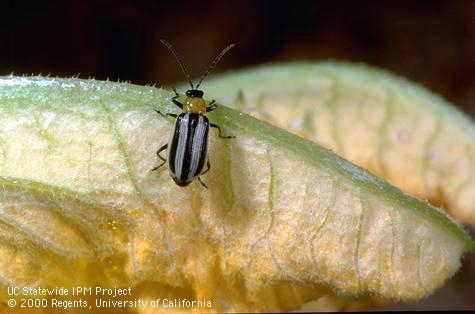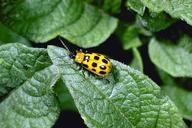Posts Tagged: damage
New UC IPM photo repository shows plant damage from herbicides
Identifying nontarget crop and ornamental plant damage from herbicides has become much easier with the launch of a new online photo repository by the...
The Pretty, Persistent Peach Tree Pest
Late July, while foraging through peach tree branches to pick the ripe fruit, I paused to stretch my back and was inundated with sawdust tumbling off the leaves. The more I looked, the more I realized the woody grains were localized in one area. Figuring the wind carried the debris onto my backyard tree, I hosed it off and went on with the day. But after several occasions of being greeted with a layer of sawdust on the same leaves, I grew curious. During an inspection of the old tree, I discovered two bore holes that penetrated into the wood over three inches deep with the openings as round as my index finger.
What on earth is drilling such large holes in this tree? I wondered.
After research revealed the attacker was a peach tree borer, Synanthedon exitiosa, I kept watch for the adult insect and larvae whose photos are displayed online at http://ipm.ucdavis.edu/PMG/r602301211.html (click the first word of the third sentence: Adults.) Although I never saw the “Adult peach tree borer” featured in one of the photos (which I later learned is the smaller more slender male whose both wings are transparent), I did see the female in my tree.
And let me tell you, this gal was gorgeous. She measured about one and a half inches long and sported a dark almost black steel-blue body with dark black-like forewings and clear hind wings with black margins. A brilliant orange band encircled her abdomen. (See photo below and visit http://bugguide.net/node/view/216752/bgpage for a great closeup shot).
Needless to say, I stood beside my peach tree transfixed — debating whether to bolt for the kitchen bug killer or race to the far end of the house to get my camera. The spray can won, so I let that flying flirt flitting through the branches have it. Despite searching both tree and ground for her body to preserve for pictures, I never saw the pretty and persistent Synanthedon exitiosa again.
Unfortunately, I learned that I’ll have to wait until next spring to know for sure if she’s really gone and how many borers she left behind. Since females lay an average of 500-600 eggs, who knows how many larvae are tunneling their way deeper through the bark and into the sapwood of my tree? Next spring I could come face to face with more culprits after pupation takes place and the next generation of moths emerge. To prevent the possibility of another attack, I filled the bore holes with the bug killer and my husband sawed off the large tree limb that was penetrated. In the meantime, I’ll encourage the ants, spiders and lacewings and the birds that prey on the eggs and larvae.
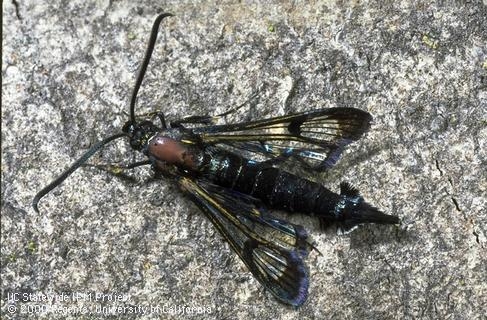
Adult male peachtree borer (photo UC IPM online)
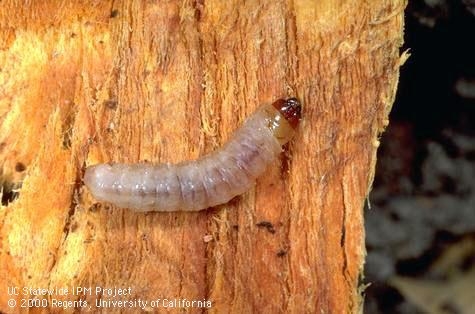
Peach tree borer larva (photo UC IPM online)
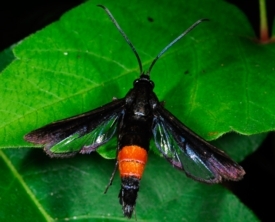
Female peach tree borer (photo from Univ. of Kentucky Ag. dept)
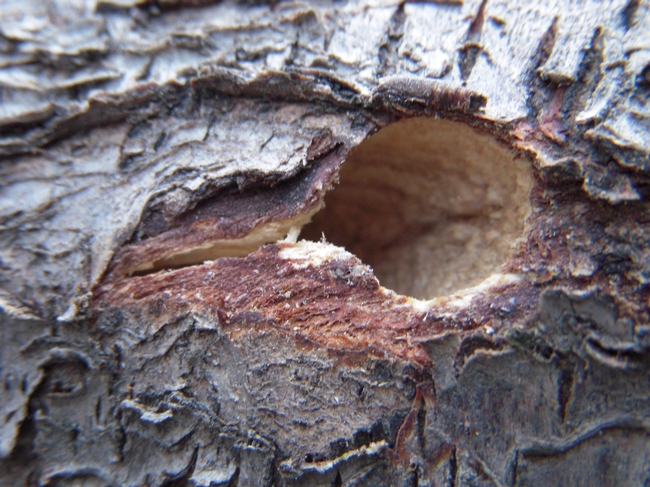
Bore hole on side of limb - photo by Launa Herrmann
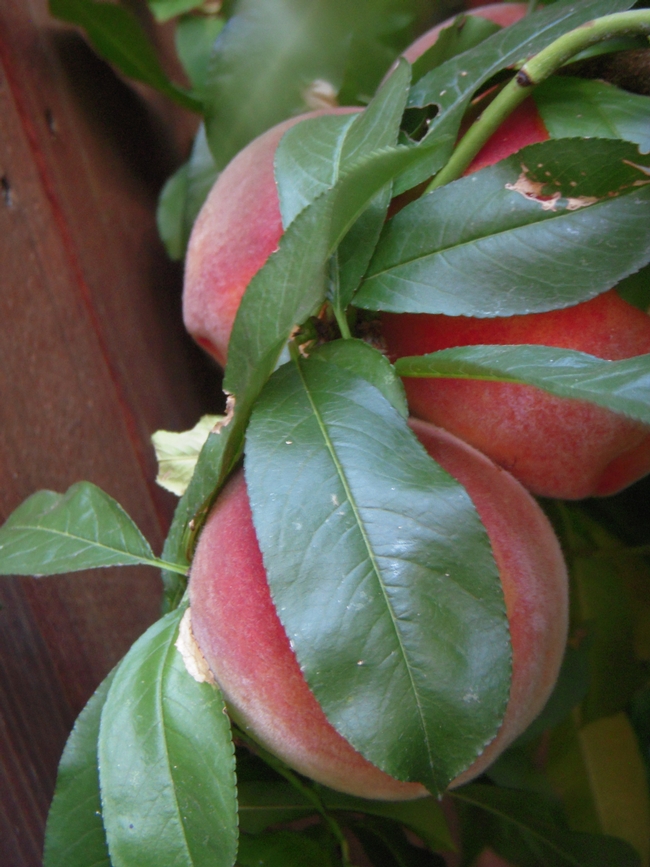
Peaches by Launa Herrmann
Grassfire-Too Close to Home
It’s been just a few days since a grassfire and embers swept over a freeway sound wall and destroyed two homes in Fairfield. In a matter of minutes, a whole neighborhood had to be evacuated, lanes of eastbound Interstate 80 were closed, and firefighters from all over the area put it in high gear and won the upper hand on this fire. A cause may never be known. Amazingly, thankfully, no one was hurt.
But this fire illustrates how quickly things can go wrong. Our very dry winter and spring have left everything super parched — the wild grasses, landscape trees and shrubs, roofs and wood siding on houses. And it’s not even fire season in California yet.
So what are you doing about it? A recent editorial in The Reporter in Vacaville (“Give credit and take measures: Fire danger is high,” Aug. 29) put it well: “The fact that this happened in a residential neighborhood well inside the city limits should be a wake-up call to everyone who lives around here. No one can do anything about the winds that drove the flames — they show up just about every afternoon this time of year — but there are precautions property owners can take to reduce the chance of damage.”
Images of the massive Rim fire in Tuolumne County came to mind. Those firs and redwoods are going up like Roman candles. We in Solano County are justifiably proud of our big, beautiful landscape trees. But when it’s this dry, are they safe to have near your house?
The Reporter editorial goes on: “Start by looking at the trees in the yard. If the foliage is touching the ground, close to a bush or hanging over the house or patio, trim it.
“And consider what is planted in the yard. At different points Tuesday (the day of the fire), the fire got a boost from oily eucalyptus and flammable Italian cypress trees.”
The editorial suggested a visit to Cal Fire’s home-safety website, Readyforwildfire.org. I recommend we all take a look, and then stroll around our homes to see what we can do to reduce our risks of losing some or all of it.
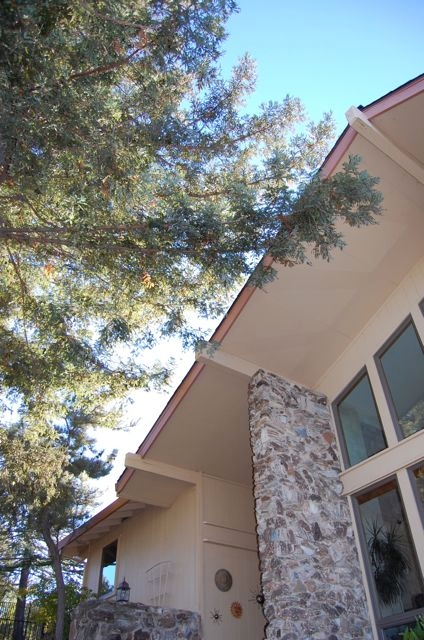
Redwood boughs hang over the roofline of this Vacaville home. Time to call a certified arborist! (photo by Kathy Thomas-Rico)
Katydids in My Yard?
A few weeks ago I was out admiring my daylilies and noticed what, at first glance I thought was a mantid. Excitedly I ran for my camera. However, as soon as I began to really look at my "mantid" I became suspicious. The forelegs weren't those I expected. And, hold on, those were definitely the legs of a jumper! So what I really had was either a katydid or a grasshopper. I was not nearly as happy as I had been a few moments before.
In doing a little research, I learned that the true katydid (Tettiginiidae) is a relative of the grasshopper, but not actually a grasshopper. The katydid is green, grows to 2 or more inches in length and has oval-shaped wings and long black-and-white antennae. It lives where there are lots of trees and shrubs, which provide its food, preferably deciduous trees, and especially oaks. The eggs hatch in the spring and the katydid goes through several molts, becoming more and more adult with each molt. Interestingly, while they can fly they do so only for short distances, preferring to walk or climb to reach their next meal.
Well, my little specimen was in our front yard directly under our Valley Oak (Quercus lobata) and fit every description of a katydid--except that I could not really identify its oval wings. So, what to do?
In checking the UC IPM website, I learned that in a healthy garden parasites will attack the katydid eggs, thereby keeping them under control. Clearly I don't have an infestation, so I guess I'll let nature take its course.
Oh, and by the way, a few days later I noticed several carefully scalloped leaves on the roses in my back yard. Hmmm....could that katydid have been feasting on a few things besides the oak! (Actually this turned out to be leaf utter bee "damage". Leafcutter bees are beneficial insects.)
Resources
http://www.fcps.edu/islandcreekes/ecology/true_katydid.htm
Wikipedia (grasshoppers)
www.ipm.ucdavis.edu
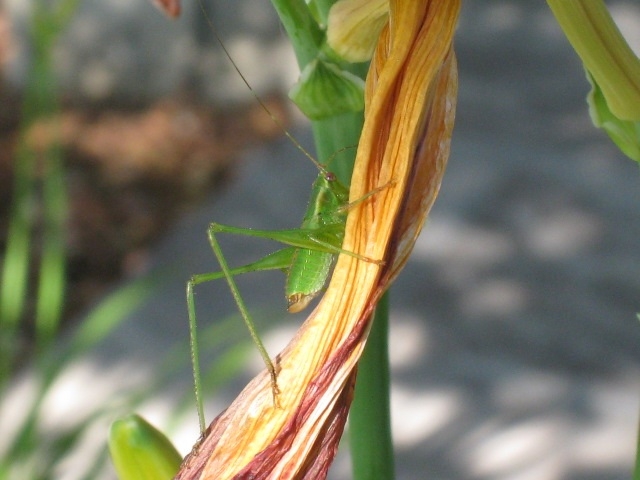
Katydid. (Photos by Marian Chmieleski)
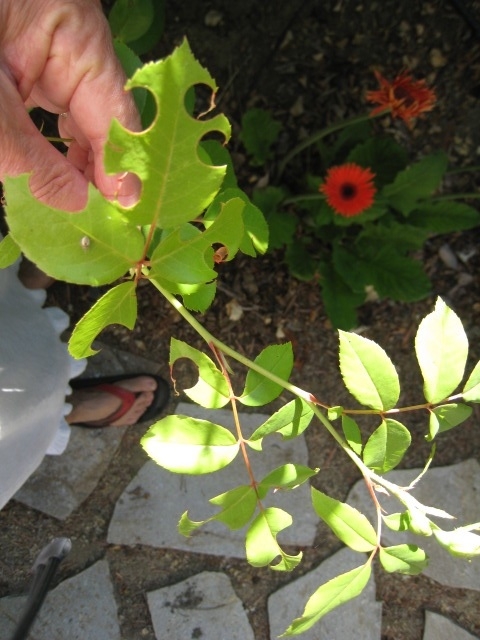
Beneficial leafcutter bee "damage".
Corn Rootworms Outwit Genetically Modified Seed
My genealogical roots deep run through many a corn field since I was born from a Nebraska-farm girl mother and an Indiana-raised father. Field corn. Popcorn. Sweet corn. You name the corn, my relatives planted it. Several decades back I even grew ornamental corn one summer to decorate Christmas wreaths. So needless to say I was riveted to a recent Wall Street Journal article about how Mother Nature is outsmarting genetically modified corn seed. (Ian Berry, “Pesticides Make a Comeback”, Wall Street Journal, May 22, 2013, p. B-1.)
Seems that entomologists at the University of Illinois and Iowa State University found corn rootworms immune to Monsanto’s Bt (Bacillus thuringiensis) gene. That gene was originally designed to shield corn crops from this pest that feeds on leaves, tassels and silks; injures roots and can stunt or kill young shoots and plants.
The article also points out that last year America’s farmers planted 97 million acres in corn based on increasing prices and EPA approval touting reduced insecticide use that would give growers and farm workers “greater safety, protect water bodies from runoff and mitigate” harm to wildlife.
“Some of those gains are quickly being reversed,” said Michael Gray, a UI entomologist quoted in the story, who went on to say that next year over a quarter of corn farms plan to use insecticides as “cheap insurance.”
Makes senses now why sales are up for pesticide producers. To read the entire article, log on to WSJ online or review a similar story “Pesticides make a comeback against Monsanto seed” at
http://www.bignewsnetwork.com/index.php/sid/214688991/scat/3de2685784ae51b
Frankly, I wanted to know exactly what this crawly critter chomping on corn crops looked like. During my research of “corn rootworms,” I discovered crop damage is not limited to larvae but includes the adult — two familiar beetles often found in our own backyard vegetable patch that also feeds on cucurbits, legumes and grasses — the Western striped cucumber beetle (Acalymma trivittatum) and the Western spotted cucumber beetle (Diabrotica undecimpunctata undecimpunctata). (See UC IPM Pest Management Guidelines: Corn, plus UC ANR Publication 3443. Also UC IPM Pest Management Guidelines: Curcurbits, plus UC ANR Publication 3445.)
Photos below are of the Western striped cucumber beetle and the Western spotted cucumber beetle).
And there’s more. In fact, there’s also a banded cucumber beetle (Diabrotica balteata) and a spotted cucumber beetle (Diabrotica undecimpunctata howardi), also known as the Southern corn rootworm. In addition, there’s the Northern corn rootworm (Diabrotica barberi Smith & Lawrence), and the Western corn rootworm (Diabrotica virgifera virgifera LeConte).
When you compare the above two photos with photographs on Purdue University’s IPM website, you’ll notice that our Western spotted cucumber beetle looks identical to the Southern corn rootworm and that our Western stripped cucumber beetle appears the same or similar to the female Western corn rootworm. Plus, there’s a photo of the larvae -- the actual rootworm. Here’s the Purdue IPM link:
http://extension.entm.purdue.edu/fieldcropsipm/insects/corn-rootworms.php


